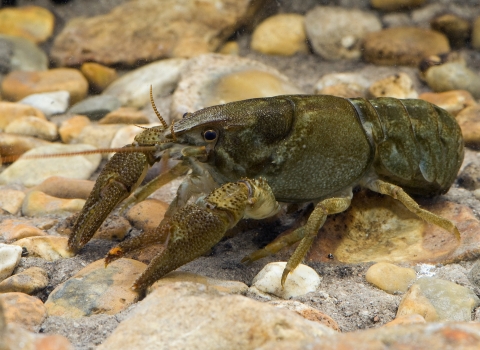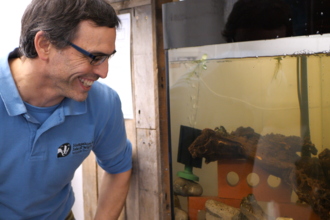
White clawed crayfish © Linda Pitkin/2020VISION
Southern Chalk Streams
Chalk streams are not only beautiful, they are also exceedingly rare.
England has 85% of the world’s 200 chalk streams, many of which are found in Hampshire. This project aims to protect this precious and stunning habitat, and the threatened invertebrates that call them home.
A diverse invertebrate community is fundamental to a healthy chalk river or stream, providing food for fish and mammals and acting as freshwater detritivores, herbivores and predators. These species, which are often overlooked in conservation, are threatened by habitat loss, habitat decline, pollution, abstraction and invasive non-native species.
In particular, this project, focuses on the nationally and internationally threatened white-clawed crayfish.
Project objectives
Raise awareness of the issues threatening chalk river species, with particular reference to white-clawed crayfish;
Improve knowledge of the ecology and distribution of crayfish, providing technical guidance and assistance to boost the development of important habitat features;
Working with land and river owners and managers to encourage habitat enhancement;
Developing novel schemes and new strategies to secure the long terms survival of white-clawed crayfish.
White-clawed Crayfish © Ben Rushbrook
White-clawed crayfish
The UK’s only native species of crayfish and an internationally endangered species.
The white-clawed crayfish has suffered a dramatic decline across Britain and Europe.
It is believed that a large majority of white-clawed crayfish populations in the UK have been lost, and without active conservation this species could be lost from Britain altogether.
The North American signal crayfish and the disease ‘crayfish plague’ that they carry is the single biggest cause of the dramatic decline
White-clawed crayfish underwater © Ben Rushbrook
Creating arks
These are isolated, self-contained sites that will include river headwaters, lakes and ponds. Sites must able to support healthy, self-sustaining populations of crayfish with little need for ongoing management.
- To meet the criteria of an ark site the waterbody must be:
- Free of any existing crayfish populations.
- Have little or no recreational activity, such as water sports, dog swimming or stocking with fish for angling.
- Must not dry up during the summer.
- Should be no smaller than 0.1 hectare (1000m2) in size.
- Absence of and low risk of colonisation by non-native crayfish species.
We believe the areas with most ark site potential are in the north of Hampshire, from the west of Andover across to Basingstoke, and in the east of the county, in the areas to the north and south of New Alresford. If you are an interested landowner whose land includes bodies of water with ark site potential, or if you think you may know of such a site, please contact the Trust on Ben.Rushbrook@hiwwt.org.uk.

White-clawed crayfish © Andy Sands, naturepl.com
Crayfish and River Users booklet
Read more about the white-clawed crayfish and how you can help this threatened species in our
You can help in many ways
With your help we can continue to protect precious chalkstreams for the benefit of endangered wildlife and people of all ages who value the area’s outstanding natural beauty.
Get informed
Read: Crayfish and River Users to find out how you can help white-clawed crayfish.
Prevent the spread of diseases
Crayfish plague is the main cause for the loss of white-clawed crayfish populations. By checking, cleaning, disinfecting and drying your equipment and boots you can help to prevent the spread of diseases between sites.
See full details below for preventing the spread of diseases
Volunteer
Contact Ben Rushbrook: ben.rushbrook@hiwwt.org.uk or call: 01489 774421 to find out more about volunteering.
Report sightings of protected species
Map the location of southern damselfly and crayfish – you can send the details to Ben Rushbrook: ben.rushbrook@hiwwt.org.uk or call: 01489 774421.
Landowners and managers
Landowners and managers can get support to learn how to manage land sympathetically for these species and to learn what in-channel and floodplain features are beneficial for aquatic invertebrates and other chalk river species.
Become a member
Preventing the spread of diseases
By following these four simple steps you can reduce the spread of invasive species and the diseases they carry, and thereby help to protect precious wildlife.
1. Check
Check before leaving a site that you don't have any small animals or plant fragments on your equipment and remove any that are present. If introducing fish or plants into your river, lake or pond, are you sure that it isn't from a donor site that harbours non-native animals, plants or diseases?
2. Clean
Clean any mud, dirt or stones from your boots. Do this before leaving site where possible but always well away from a new watercourse.
3. Disinfect / Hot water
If feasible soak your equipment in a disinfectant or water above 45°C for 15 minutes or more. This step is all the more important if you know you are taking wet equipment to a new site.
4. Dry
Completely drying your equipment in direct sunlight for 24-48 hours kills all waterborne organisms and diseases.
Diseases are of particular concern as they can readily be transmitted on equipment such as boots, nets and boats. This problem is intensified by the fact that diseases can remain alive out of water for days or even weeks if the equipment stays wet!
More information...
For more information or advice on planning and implementing crayfish related or general bio-security measures please contact Ben Rushbrook, Senior Ecologist on 01489 774421 or at ben.rushbrook@hiwwt.org.uk
Latest news & blogs
New Breeding Centre strengthens efforts to save endangered white-clawed crayfish
A new Native Species Zone has officially opened at Marwell Zoo, marking a significant step in efforts to safeguard the endangered white-…

Watercress and Winterbournes boosts new crayfish conservation centre
The Isle of Wight has gained a conservation centre for endangered native crayfish, with support from the Watercress and Winterbounes…

Conservation programme for Endangered native crayfish gets Isle of Wight boost
A new conservation centre on the Isle of Wight is set to become a key part of a conservation programme to secure the future of the…

